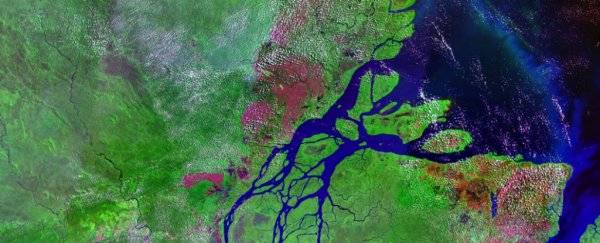An international team of researchers has discovered a 1,000-km (600-mile) long coral reef sitting at the murky, muddy mouth of the Amazon river.
The incredible discovery proves that no matter how well we think we've mapped the surface of our planet, there are still secrets left for us to discover. In this case, a huge, flourishing sponge and coral reef that appears to stretch from the southern tip of French Guiana all the way to the state of Maranhão in Brazil.
The announcement also comes at a time when we're running incredibly low on hope for coral reefs everywhere - just this week scientists admitted that 93 percent of the Great Barrier Reef has now been bleached, and large portions might not recover. So the discovery of a new reef is welcome news. But how the hell did it go so long without anyone spotting it?
The reef was able to remain hidden so well because the mouth of the Amazon is, to be frank, a little bit of a mess. Out of all the water that flows from Earth's rivers into Earth's oceans every day, roughly one-fifth of that water pours out here, at the mouth of the Amazon.
With that, come nutrients, waste, and organic matter collected along the river's 6,992 km (4,344 mile) winding journey through the rainforests and farmlands of South America. And by the time it reaches the water, it bring a whole lot of mud and triggers plenty of algae blooms, both of which cloud the water of the flume.
"I kind of chuckled when [Brazilian oceanographer Rodrigo Moura] first approached me about looking for reefs. I mean, it's kind of dark, it's muddy - it's the Amazon River," one of the researchers involved, Patricia Yager, told Robinson Meyer over at The Atlantic.
"But he pulls out this paper from 1977, saying these researchers had managed to catch a few fish that would indicate reefs are there. He said, 'Let's see if we can find these.'"
The paper in question, from almost 40 years ago, described species of reef fishes and sponges being dredged up from the mouth of the Amazon - and these species were unique to the tropical flora and fauna you'd find in the islands of the Caribbean.
But since then, no one had really given it much thought - after all, given our general understanding of coral reefs, would you expect to find any under here?
 Image: Lance Willis via Patricia Yager
Image: Lance Willis via Patricia Yager
Yager wasn't even there to look for the reefs. She was using the RV Atlantis to look into how Amazonian plume was affecting carbon dioxide absorption in the ocean. But to get approval to study the mouth of the Amazon she needed to get some Brazilian oceanographers involved, and one of those, Rodrigo Moura, asked for her help looking for the reef while they were there.
To everyone's surprise, when the put down the dredger, it came up with sponges, stars, and fish. "I was flabbergasted, as were the rest of the 30 oceanographers," Yager told The Atlantic.
The discovery makes the reef the most northernmost known in Brazil, Meyer reports.
What was most surprising is the fact that the reef can exist at all, given the fact that all the mud in the Amazonian plume keeps it sheltered from the Sun most of the time. But return trips by Moura and other Brazilian scientists have suggested that the biology of the reef changes depending on its location, and how much Sun it gets.
The southern section is only covered by the plume three months of the year, so its environs can complete more photosynthesis. (Most corals live in symbiotic relationships with photosynthetic algae that inhabit their pores.) The southern section contains more staghorns and other colourful corals, "much more what you might imagine a coral reef would look like," says Yager. The north section, dominated by sponges and carnivorous creatures, is shielded from sunlight by the muddy plume more than half of the year.
There still more investigation to be done into the species that live in this new reef. But according to Rebecca Albright, an oceanographer and coral researcher from the Carnegie Institute for Science, who wasn't involved in this study, the find is a pretty big deal.
"Traditionally, our understanding of reefs has focused on tropical shallow coral reefs which harbour biodiversity that rivals tropical rainforests," she said. "The new Amazonian reef system described in this paper is another example of a marginal reef that we didn't previously know existed."
The research has been published in Science Advances. You can also read more about the discovery over at The Atlantic.
